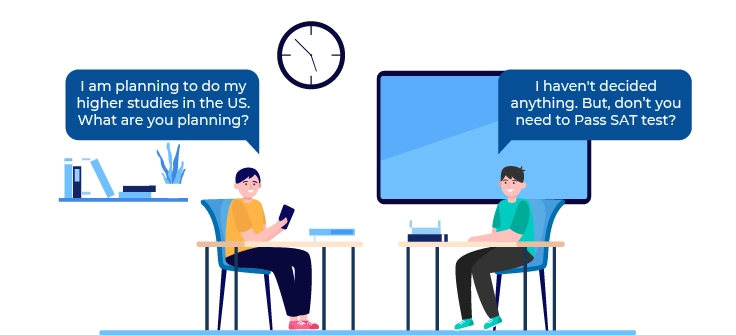 Blessy Babu
Aug 08, 2025
Blessy Babu
Aug 08, 2025

The SAT measures students' readiness for college-level admissions in countries like Canada, Australia, and the USA. Universities in other countries are now increasingly recognizing SAT scores for the admission of international students. A good SAT score can open doors to scholarships and admission to a top university.
The SAT exam has shifted completely to a digital format, aligning with modern educational practices and technological progress. If you are going to prepare for the SAT exam to achieve your academic aspirations, you should know about the SAT exam format, syllabus, etc. Let’s learn some of the important aspects of the SAT exam.
SAT stands for Scholastic Assessment Test. It was previously known as the Scholastic Aptitude Test, and then the Scholastic Assessment Test, but is now officially called simply the SAT. It evaluates essential academic skills such as reading, writing, and mathematics, serving as a benchmark to compare students from diverse educational backgrounds. The SAT is developed, administered, and managed by the College Board, a non-profit organization based in the United States.
The Digital SAT (DSAT) is the new computer-based version of the SAT exam. It features a shorter test duration, adaptive modules, and calculator use on all math questions. The digital SAT incorporates shorter reading passages and more direct questions. The DSAT is administered on a computer, offering flexibility in terms of where and when students can take the test.
Many popular colleges and universities consider SAT score as a strong indicator of a student's academic readiness. For students preparing through SAT training programs, understanding its importance can help guide preparation strategies and maximize their score potential for college applications. The benefits of SAT exam scores include;
The SAT is mostly for high school students targeting undergraduate admissions or scholarships, but it’s open to anyone wanting to showcase their academic skills for college-bound goals. This includes;
The revised SAT exam syllabus has 2 sections: Reading & Writing and Math, with an optional essay section. The Math section is further divided into calculator and no-calculator portions.
Digital Format: The SAT has transitioned to a fully digital format, replacing the paper-based version.
Two Main Sections in the SAT Exam:
Optional Essay: The essay section is now optional, meaning students can choose whether or not to take it.
Adaptive Testing: The SAT uses adaptive testing, meaning the difficulty of questions in the second module of each section adjusts based on the student's performance in the first module.
Scoring: The total SAT score ranges from 400 to 1600, with each section (Reading & Writing and Math) scored from 200 to 800.
Question Types: The Reading and Writing section is entirely multiple-choice, while the Math section includes both multiple-choice and student-produced response (SPR) questions, according to a study abroad resource.
No Negative Marking: There is no penalty for incorrect answers.
The total testing time is 2 hours and 14 minutes, not including breaks, and the test consists of:
| Feature | Reading & Writing | Math |
|---|---|---|
| Total Time | 64 minutes (2 modules of 32 minutes each) | 70 minutes (2 modules of 35 minutes each) |
| Total Questions | 54 | 44 |
| Adaptive | Yes | Yes |
| Question Type | Multiple Choice | Multiple Choice and Student-produced Response |
| Calculator Use | N/A (integrated digital calculator available) | Permitted for the entire section |
| Score Range | 200–800 | 200–800 |
| Format |
Digital, online via College Board's Bluebook app
|
Digital, online via College Board's Bluebook app |
| Content Focus |
Short reading passages, grammar, vocabulary, comprehension, and editing
|
Algebra, problem-solving, data analysis, advanced math, geometry, and trigonometry |
| Scoring |
Integrated within the section
|
Integrated within the section |
The revised SAT exam syllabus has 2 sections: Reading & Writing and Math. The Reading & Writing section evaluates a student's comprehension, analytical skills, and ability to effectively communicate ideas through written language. The Math section evaluates a student's proficiency in mathematical concepts and problem-solving abilities.
The Reading and Writing section of the SAT evaluates a variety of skills across four key domains, making it a crucial component of your overall score. To boost your SAT performance, consider a well-defined SAT reading tips. Additionally, getting familiar with the SAT reading and writing exam syllabus. This includes;
| SAT Reading & Writing Section Areas | Question Distribution | Skill / Knowledge Testing Areas |
|---|---|---|
| Craft and Structure | 13-15 | Words in Context, Cross-Text, Text Structure and Purpose, Connections |
| Information and Ideas | 12-14 | Command of Evidence based on – Textual and Quantitative Inferences, and Central Ideas and Details |
| Expression of Ideas | 8-12 | Rhetorical Synthesis Transitions |
| Standard English Conventions | 11-15 | Boundaries Form, Structure, and Sense |
The SAT Math test evaluates how well students understand and apply mathematical concepts in real-world scenarios. Test-takers are allowed to use a calculator throughout this exam section, facilitating the solving of complex problems efficiently. The SAT Digital Math syllabus, along with the weightage percentage of the SAT exam syllabus for mathematics, is as follows:
The SAT exam registration process is open for all students for the entire August 2025-June 2026 test year. All deadlines expire at 11:59 p.m. ET, U.S. These SAT exam dates and deadlines apply to all students, including U.S. and international students. The SAT exam calendar for 2025 and 2026 is as follows;
| SAT Test Date | Registration Deadline | Deadline for Changes, Regular Cancellation, and Late Registration |
|---|---|---|
| Aug. 23, 2025 | Aug. 8, 2025 | Aug. 12, 2025 |
| Sept. 13, 2025 | Aug. 29, 2025 | Sept. 2, 2025 |
| Oct. 4, 2025 | Sept. 19, 2025 | Sept. 23, 2025 |
| Nov. 8, 2025 | Oct. 24, 2025 | Oct. 28, 2025 |
| Dec. 6, 2025 | Nov. 21, 2025 | Nov. 25, 2025 |
| March 14, 2026 | Feb. 27, 2026 | March 3, 2026 |
| May 2, 2026 | Apr. 17, 2026 | April 21, 2026 |
| June 6, 2026 | May 22, 2026 | May 26, 2026 |
Now that you have the upcoming SAT exam Calendar, the next step is to choose the exam date that suits your schedule and register for it. To register for the SAT exam, visit the College Board website. You'll need to create a College Board account or log in to an existing one. Then, follow the prompts to select your test date and test center, upload a photo, and pay the registration fee.
Here's a more detailed breakdown:
Detailed breakdown of fees:
| Fee Type | Amount (USD) |
|---|---|
| Standard Registration | $68 |
| Change test center | $34 |
| Cancel fee | $34 |
| Late cancel fee | $44 |
| Late registration | $38 |
A total SAT score can range between 400 to 1600. Each section in the SAT ( Reading & Writing and Math) is scored on a scale of 200 to 800. You will receive your SAT score within a few days of attempting the SAT exam.
You will be considered an above-average student if your SAT score exceeds 1050. Scoring 1350 or above will put you in the top 10%, increasing your chances of getting admission to top universities.Thorough SAT practice exams and effective coaching will help you achieve your target score. You can follow effective tips to improve your SAT Score.
Here's a detailed table of SAT Scoring and Results for 2025:
| Section | Score Range | Details |
|---|---|---|
| Average SAT Score (2025) | 1050–1100 | Estimated national average for 2025 based on trends. |
| Reading and Writing | 200 – 800 | Tests comprehension, vocabulary, grammar, and evidence-based reading. |
| Math | 200 – 800 | Covers algebra, problem-solving, data analysis, and some advanced math. |
| Total Score | 400 – 1600 | Combined score from Reading/Writing and Math. |
| Score Validity | 5 Years | SAT scores remain valid for 5 years after the test date. |
| Score Release Time | 13 days | Digital SAT results are typically released within 13 days of the test. |
| Superscoring | Allowed | Many colleges accept the highest section scores from different test dates. |
| Percentile Rank | 1st – 99th | Shows how a score compares to other test-takers. |
Now that you know everything about the SAT exam, the next important step is to figure out how to prepare for the SAT. To help you get started, here are 10 helpful tips for students aiming to take the SAT Exam in 2025:
|
|
The SAT is important for college admissions because it provides a standardized measure of academic ability, allowing colleges to compare applicants from diverse educational backgrounds. A strong SAT score can significantly improve a student's chances of getting accepted into their desired institution, especially at more competitive colleges.
To maximize your SAT score, it's crucial to start planning early and seek expert guidance. Early planning allows for ample time to study, identify weaknesses, and develop effective strategies. Get familiar with the digital interface and question types to achieve a good SAT score. Choose the SAT coaching center that aligns with your budget and academic goals. Ensure you have completed mock tests and done last-minute preparations before the SAT exam. Good luck!

Blessy is an experienced medical instructor who specialises in Prometric courses and NCLEX preparation. She has a wealth of knowledge in healthcare education and is highly skilled in teaching and training healthcare professionals. Her main aim is to support students in passing their Prometric exams and NCLEX certification by providing them with comprehensive and up-to-date study materials, personalised instruction, and hands-on practice exams.
Blessy's teaching approach centers on creating a supportive and engaging learning environment that encourages critical thinking, problem-solving skills, and effective test-taking strategies. She is committed to professional development and keeping up-to-date with the latest trends and advancements in the medical field. As part of her commitment, she regularly attends workshops, conferences, and seminars to enhance her expertise, ensuring that her students receive the most relevant and valuable education.